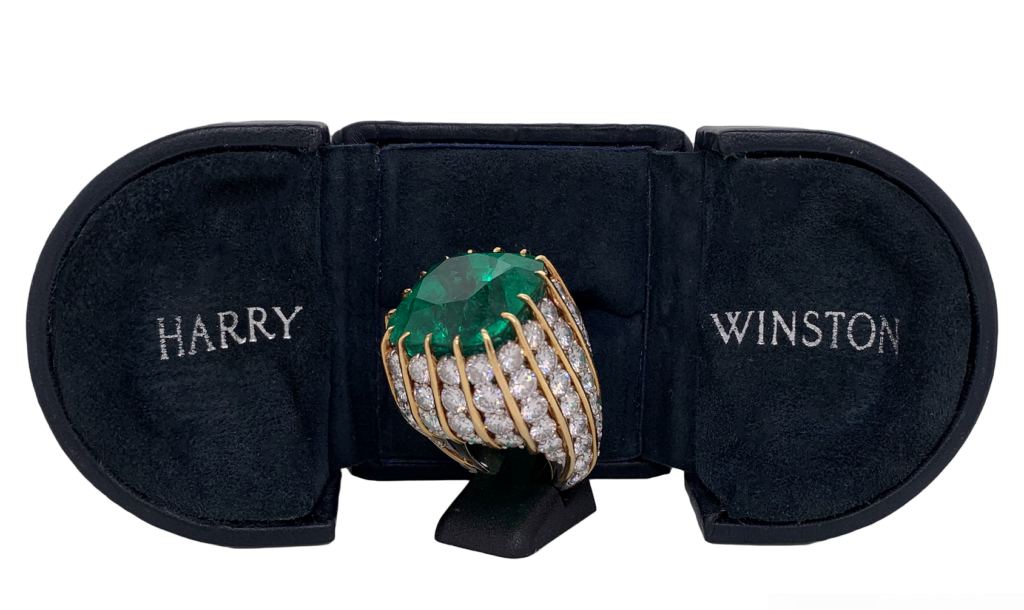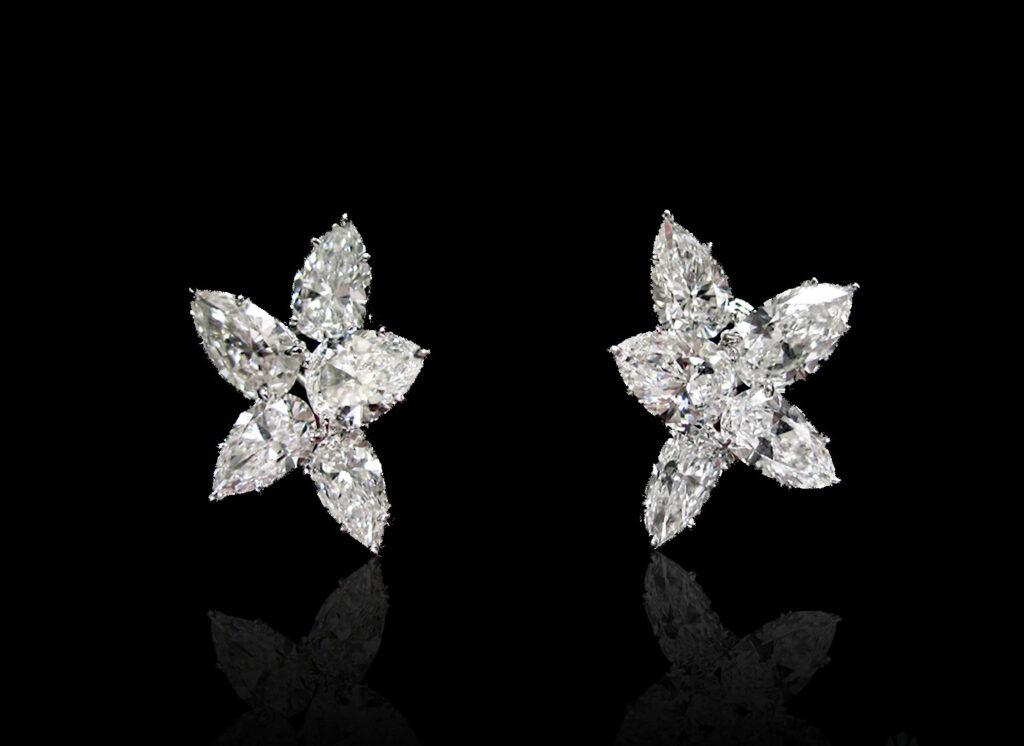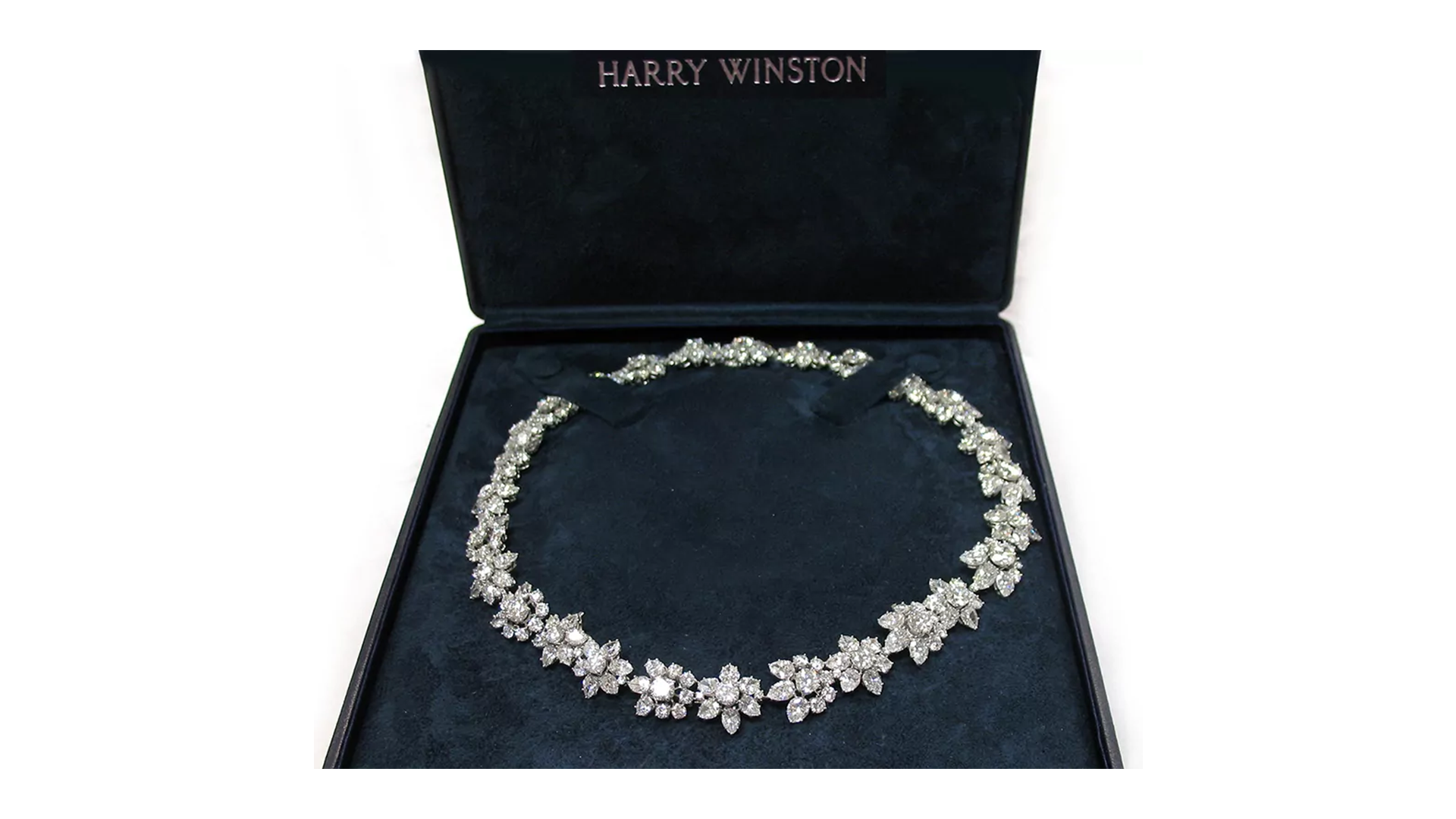Floral motif diamond and platinum necklace, converts into two bracelets, circa 1959, courtesy J&SS DeYoung.
From the red carpet to royalty Harry Winston jewels are seen sparkling on some of the world’s best known luminaries at some of the world’s most high profile events. Winston himself became quite famous due to the important diamonds and gemstones that he acquired and through his penchant for sharing his passion for diamonds and gemstones with the public.
Harry Winston was born in New York City in 1896. His father had a small jewelry shop and young Harry spent a great deal of time there. The defining moment for his future career as a purveyor of exceptional diamonds and colored gemstones happened when he was just 12 years old. Winston stopped by a pawn shop and was looking through some costume jewelry, when he saw a green stone. The pawn shop owner thought it was a piece of glass, but Winston knew better. He bought the stone for 50 cents. Two days later he sold it for $800. The piece of glass was actually an emerald.
In 1909, Winston’s family moved to Los Angeles where they opened a store. Young Winston worked there alongside his father before moving back to New York City a few years later.
Harry Winston’s First Company
When Harry Winston arrived back in New York City, in 1920, he opened his first business, the Premier Diamond Company. After opening the Premier Diamond Company, Winston realized the complexity of the diamond market and breaking into it with few resources. Known for being an astute business person, Winston made a name for himself by purchasing the estates of well-known socialites, industrialists and other notable families. These acquisitions gave Winston access to diamonds and colored gemstones that he would not have otherwise been able to acquire. He often took the jewelry apart and reused the stones in his own creations.

Winston incorporated his business in 1932. And a couple of years later he was making headlines with the purchase of the famed Jonker Diamond, the 726-carat rough diamond was discovered in South Africa and named after the miner who found it. Winston brought the rough diamond back to New York and promptly sent it out on a press tour around the country. While on tour the uncut diamond was photographed with stars of the silver screen, Shirley Temple and Claudette Colbert. After its press tour the Jonker was finally cut, yielding 12 gems, with the largest weighing 125.35-carats.
That was the start of Winston and his connection to some of the most important diamonds in the world. Harry Winston has also been the guardian of the Vargas Diamond, Winston Diamond, Star of Independence, The Washington and perhaps most famously, the Hope Diamond.
Court of Jewels
Harry Winston and diamonds were so inextricably intertwined that in 1947 Cosmopolitan Magazine, dubbed him the “King of Diamonds”, a title that stayed with him for the rest of his life. Winston loved sharing his passion for jewels with other people and wanted to make sure that the public was informed about gemstones. He also had a passion for philanthropy, so in 1949 he created another headlining event: “The Court of Jewels” a traveling exhibition of spectacular gemstones and jewelry. The exhibition toured several cities and in each destination money was raised for local charities. He later donated The Hope Diamond and some of the other items from “The Court of Jewels” to the Smithsonian Institution. In fact, he mailed The Hope Diamond to the museum through the United States Postal Service.
The Harry Winston Cluster

Harry Winston is known for the use of exceptional diamonds and gemstones in its jewelry. Winston always let the stone dictate the design rather than the setting being the main focus. With that in mind, the cluster design is one of his most renowned creations and the idea came from a rather unusual source: A holly wreath.
Winston arrived home in Scarsdale one winter night and glanced at the wreath on his front door that was sparkling with snow and frost. The next day Winston went to his head designer, Nevdon Koumrouyan and together they created the now iconic “cluster” design. The Cluster which features diamonds in round, pear and marquise shapes all in one piece is designed so that the gems are angled and in perfect proportion to each other creating spectacular sparkle. The diamonds are always set in platinum so that the setting is barely visible instead emphasizing the gems so they appear to be floating. It’s a look that is closely associated with the firm.
Hollywood has come knocking on Harry Winston’s doors many times. Its sparklers have been worn in a number of films including the Alfred Hitchcock movie “Notorious”, “The Graduate” and “How to Lose a Guy in 10 Days”. And who could forget Marilyn Monroe in “Gentlemen Prefer Blondes” purring the famous line – “talk to me Harry Winston” — as she sang “Diamonds Are a Girl’s Best Friend”. Winston also started the trend of loaning jewels to stars walking the red carpet for various award shows, which earned him a second nickname: Jeweler to the Stars.
Harry Winston passed away in 1978. His son, Ronald Winston took over daily operations of the business until he retired in 2008. The company was sold to Aber Diamond Mine, which later sold the company to Swatch. But Winston’s legacy of “rare jewels of the world” continues to today as a new generation of clients discover the magic of his jewelry.
Authored by Amber Michelle
